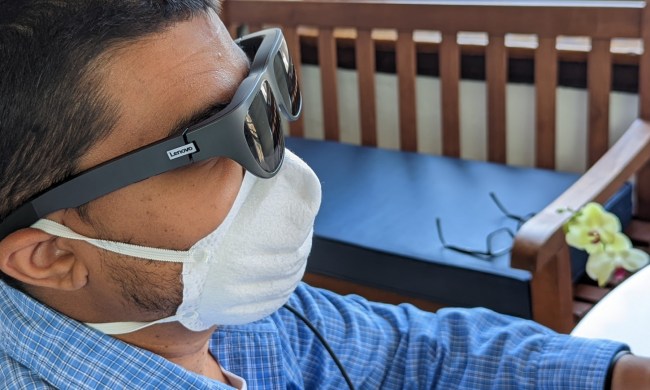“Sony's new VAIO C1MW PictureBook Series Notebook blurs the boundaries of both form factors...”
- Sleek design
- many features
- Under powered compared to similiarily priced laptops
Because this form factor falls halfway between a PDA and a notebook, the obvious tendency is to pit this Sony against other products clearly marketed at different audiences. While this is not a fair comparison, one cannot help but see the disparity in price per performance between the Picturebook and notebook. Consider you can buy a more powerful notebook for roughly half of the price of this Picturebook. Alternatively you could buy a notebook with about twice the performance as the Picturebook for approximately the same price. It is also does not help that the next closest competitor – the PDA – is far cheaper. At close to one third the price the Compaq iPAQ Pocket PC also offers formidable competition. The consensus we have arrived at is that for Sony to be competitive with this product the price would have to be less than $1000. Obviously there is fierce competition within the notebook & PDA markets causing this aggressive pricing. If and when this reaches into this midrange form factor arena, I would expect Sony’s prices to be much more comparable with their PDA/Notebook counterparts.
Until then this remains purely a niche market. But do not let these comparisons detract from the advantages of this niche market. College students might find the ability to record lectures invaluable – forget for the moment that the wealthy student who might afford such a device may be an oxymoron. And recording business meetings might be invaluable to some – providing management can be convinced that they are purchasing the device for mundane office activities rather than the evening techno fun the Picturebook appears bent towards. For the technology purist the compromise in performance of this undersized notebook may not be considered acceptable – but thankfully there are people out there that prefer using technology for purposes other than comparing benchmarks – and to these the show-and-tell aspect and downright fun features may provide a more than adequate return on investment.
In case you still think the PDA & notebook are still distinguishable, guess again. Sony’s new VAIO C1MW PictureBook Series Notebook blurs the boundaries of both form factors and offers a solution to impress your family, friends, and colleagues. But at a cost of about $2000, can it really compete? Read on to find out…
Features
Two very notable features set this Sony Picturebook apart from competition; first and foremost – its petite proportions. The form factor is halfway between a PDA and a notebook; yet with nearly all the features of a full size notebook. Unfortunately it is not quite small enough to fit in your pocket, yet not quite big enough to have a full size keyboard and screen. This might leave some people wondering if there is really a need for such a crossover vehicle in the electronic realm – something we have also been pondering. The half-height LCD (1280×600) and slightly compressed keyboard probably will eliminate the device from many business, home, and gaming markets. Yet there are certainly some benefits – especially when computing on the bus, train, or plane in coach class – where even a laptop can seem bulky. The intermediate size would also allow lugging around only a small backpack or large purse. Wearing it on the hip or in the pocket will unfortunately not quite work as well as a PDA. But at only 2.2 lbs, the extra weight is nearly inconsequential if you are already using a briefcase or backpack.
Size is not the only identifying attribute of this VAIO. The built in Motion eye camera is really the most intriguing part of the design – and probably the selling feature. The camera is built in on top of the screen and can flip to point to or away from the driver. The software loads at the push of the capture button and live video begins showing up within seconds. JPEG shots or MPEG2 video can then be recorded and replayed quite easily. With the included 30 Gigabyte hard drive a quick calculation shows that about 10 hours of streaming video and audio can be recorded at a time before running out of room. The possibilities with this are actually quite interesting. The immediate application that comes to mind would be recording business meetings or lectures at school. Because the camera lens is extremely small and can flip toward the front of the room, it is far more inconspicuous than to manipulating a video camera or even a tape recorder in class. In fact it is doubtful that that it would be recognized for anything but a PDA or calculator in school. The video quality is fairly impressive, though the resolution is only 640×480. Playback may drop a few frames if other applications are going – but will look smooth after burning it on CD and playing it when you get home on your desktop. No need to be stationary while recording, but do not expect all the features of a camcorder either. Video editing software is included to allow for some decent home video creation immediately after recording.
Performance
|
Find the latest reference results on http://cpu.rightmark.org CPU Test results (13/09/2002, 17:37:53) |
|
|
System: |
Microsoft® Windows XP Home Edition Version 5.1 (Build 2600) |
|
CPU: |
Transmeta(tm) Crusoe(tm) Processor TM5800, Current clock 860 MHz, L2 cache 0 K |
|
Memory: |
245216K total, 128880K free, (add type, clock here..) |
|
Chipset: |
(add ID string here) |
|
Display mode: |
1280 x 600 @60 Hz, 32bpp |
|
Viewport size: |
100 x 75 percent |
|
Dynamic camera: |
No |
|
Offscreen rendering: |
Yes |
|
Renderer Instruction Set: |
FPU + General MMX |
|
Shadows: |
Yes |
|
Textures: |
Yes |
|
Test start/stop frames: |
100 / 700 |
|
Solver Instuction Set: |
FPU |
|
Testing Model: |
Model1 |
|
Math Solving Time: |
8.01813 (74.96 fps) |
|
Prerendering time: |
3.44469 (174.47 fps) |
|
Rendering time: |
89.1519 (6.74 fps) |
|
Number of rendered frames: |
601 (5.97 fps) |
Features Continued
Extended battery life is the biggest boast of the Transmeta Crusoe CPU inside this Sony Picturebook. Unfortunately it is also one of the more difficult to benchmark, as this CPU does voltage and frequency scaling on the fly to limit power consumption according to need. A clear comparison can be made only with a standard load, such as DVD playback. Starting with a full battery we were able to make it to just before Wesley, Fezzik and Inigo Montoya storm the castle in The Princess Bride. That is exactly 75 minutes: maybe long enough for some of those new fangled movies like MIB II, but not long enough for a true classic. Obviously the included external CD-W/DVD draws a large portion of the power, and drastically reduces the battery life. For more common sporadic usage (including benchmarking, video capture, and idle time) we were able to demonstrate an average battery life of between two and three hours. This is comparable to many notebook computers – despite some claims of the CPU manufacture otherwise. Of course, a larger battery is available if your main concern is finishing your movie on the airplane.
Several other features are notable. There is one type II card slot – which would be perfect for an 802.11b wireless card. Built in stereo speakers provide adequate volume. The audio quality during DVD playback was good – as we would expect from Sony. The high resolution (1280×600) screen is excellent for watching wide screen DVD’s, although we had to play around with the settings for a while to get the widescreen DVD to fill up the entire width and height. Unfortunately this size is not so convenient for office style applications – where viewing full pages is preferable. In such cases it would probably be a nice feature if the monitor could rotate 90°. Games and graphics also suffer due to the limited height. Fortunately a port replicator is included to allow simple docking and connection to a full size monitor. The data transfer abilities via memory stick, ILINK (IEEE 1394), and AV in/out allows quick & easy access to many nice toys: camcorders, cameras, and gadgets. Of course modem and Ethernet are also included to talk to big brother – the PC.
Setup and Installation
As expected no unusual setup or installation is necessary. Windows XP Professional is installed, as is Corel WordPerfect Office 2002. Boot time was one minute thirty seconds – perhaps a bit on the slow side when compared to other laptops, and even slower if compared to PDAs. Ample documentation is provided – but none is necessary to start playing. One push of a button pulls up the video capture program, momentarily turning the monitor into a mirror.
Benchmarks
Not intending to replicate benchmarks taken elsewhere on the Crusoe we have just run a basic set. PC Mark 2002 gave a score of 1606/1440/339 for CPU/Mem/Hdd. Below are results from Rightmark and CPU Bench. The performance on most metrics shows it slightly lower than a PentiumIII at the same frequency. This may be disappointing to some given that most similarly priced laptops have nearly twice the performance. But clearly raw performance was not the intention of this device & must be weighed accordingly.
Conclusion
Because this novel form factor falls halfway between a PDA and a notebook, the obvious tendency is to pit this Sony against other products clearly marketed at different audiences. While this is not a fair comparison, one cannot help but see the disparity in price per performance between the Picturebook and notebook. Consider you can buy a more powerful notebook for roughly half of the price of this Picturebook. Alternatively you could buy a notebook with about twice the performance as the Picturebook for approximately the same price. It is also does not help that the next closest competitor – the PDA – is far cheaper. At close to one third the price the Compaq iPAQ Pocket PC also offers formidable competition. The consensus we have arrived at is that for Sony to be competitive with this product the price would have to be less than $1000. Obviously there is fierce competition within the notebook & PDA markets causing this aggressive pricing. If and when this reaches into this midrange form factor arena, I would expect Sony’s prices to be much more comparable with their PDA/Notebook counterparts. Until then this remains purely a niche market.
But do not let these comparisons detract from the advantages of this niche market. College students might find the ability to record lectures invaluable – forget for the moment that the wealthy student who might afford such a device may be an oxymoron. And recording business meetings might be invaluable to some – providing management can be convinced that they are purchasing the device for mundane office activities rather than the evening techno fun the Picturebook appears bent towards. For the technology purist the compromise in performance of this undersized notebook may not be considered acceptable – but thankfully there are people out there that prefer using technology for purposes other than comparing benchmarks – and to these the show-and-tell aspect and downright fun features may provide a more than adequate return on investment.




